La communication est la ligne de vie de l'interaction humaine. Elle nous relie, nous façonne et est le moteur de notre réussite collective.
Maîtriser la communication n'est pas une tâche facile, mais améliorer nos compétences en la matière est essentiel pour notre vie personnelle et professionnelle. Une bonne communication peut faire la différence entre la réalisation d'objectifs communs et le fait de trébucher sur de simples malentendus.
Dans ce guide, nous allons explorer :
- Qu'est-ce qu'une compétence de communication et quels sont nos 11 meilleurs choix,
- Quels sont les types de compétences en communication que vous devriez améliorer,
- Qu'est-ce qu'une bonne communication,
- Comment communiquer efficacement sur le lieu de travail,
- Comment améliorer votre communication sur le lieu de travail et
- Pourquoi les compétences en communication sont importantes.
Nous avons également ajouté des exemples de communication réussie pour mieux illustrer les bonnes compétences en communication.
C'est parti !

Qu'est-ce qu'une compétence en communication ?
La définition de base des compétences en communication est la suivante :
Les compétences en communication (ou aptitudes communicatives) englobent un ensemble varié de capacités qui permettent à un individu d'échanger efficacement des informations, des idées et des émotions avec les autres.
Un communicateur compétent est capable de :
- Transmettre des informations sans erreur ni mauvaise interprétation,
- Communiquer avec des personnes ayant des antécédents, des points de vue et des expériences différents,
- Communiquer de différentes manières en fonction de la situation donnée et
- Se présenter sous son meilleur jour.
Sur le lieu de travail, les compétences en communication sont essentielles pour faciliter le bon déroulement des opérations, favoriser un environnement de travail positif et contribuer à la réussite globale.
Savoir communiquer avec les membres d'une équipe est vital sur le lieu de travail car cela :
- Favorise la collaboration,
- Crée des relations,
- Améliore la productivité et le bien-être, et
- Améliore le bien-être et la satisfaction des employés.
Les compétences en communication sont l'une des compétences les plus fréquemment demandées dans les offres d'emploi. L'importance d'une bonne communication est évidente, et l'amélioration de nos compétences en la matière est bénéfique à bien des égards.
Examinons maintenant les compétences spécifiques que vous devez travailler pour devenir un bon communicateur.
11 principales compétences en communication
La réponse définitive à la question « Comment être bon en communication ? » — Travaillez sur vos compétences en communication !
Mais sur lesquelles ?
Voici les 11 principales compétences en communication qui vous aideront à améliorer votre communication. Ces compétences vous aideront à vous épanouir sur votre lieu de travail et à toujours donner le meilleur de vous-même.
Compétence en communication n°1 : L'écoute active
L'écoute active est une compétence de communication essentielle qui ne se limite pas à rester silencieux pendant que l'autre personne parle. L'écoute active implique de :
- S'engager pleinement avec l'autre personne,
- Prêter attention aux indices verbaux et non verbaux,
- S'efforcer de comprendre le point de vue de l'autre personne et
- Formuler des réponses appropriées et engageantes.
Notre collaboratrice, Kristie Stocker, conférencière, consultante en leadership et coach en réussite, estime que l'écoute est la compétence la plus importante que nous devrions posséder :

« À mon avis, il s'agit de l'outil de communication numéro un. Si plus de gens écoutaient, il y aurait moins de confusion, de malentendus, de blessures, de problèmes de productivité, de rotation du personnel et plus d'employés heureux, de clients fidèles, de profits plus importants, de changements positifs.
Il convient de noter qu'écouter ne signifie pas rester silencieux pendant que l'autre personne parle, puis intervenir dès qu'elle a terminé. Écouter, c'est digérer ce que l'on dit, y réfléchir et poser des questions pour mieux comprendre. »
Si vous voulez mieux écouter, voici ce que vous devez faire :
- Faites face à l'orateur et maintenez le contact visuel,
- Soyez attentif aux signaux non verbaux,
- Écoutez sans tirer de conclusions hâtives et
- Restez concentré sur la conversation.
En revanche, voici ce que vous devez éviter si vous voulez être un bon auditeur :
- Ne pas interrompre,
- Ne pensez pas à ce que vous allez dire ensuite,
- Ne pas imposer ses propres opinions ou solutions et
- Ne pas céder aux distractions.
Notre collaborateur, Chuck Wisner, auteur et conseiller en leadership, reconnaît que l'écoute active est essentielle à une bonne communication :

« Une composante importante d'une bonne communication est l'écoute profonde. Pour cela, nous devons nous entraîner à mettre de côté nos opinions et nos jugements tranchés afin d'absorber d'autres perspectives. Lorsque notre ego s'identifie à nos pensées ou à nos jugements, notre esprit est occupé à préparer notre prochaine réplique. L'attachement à nos opinions est un obstacle important à l'écoute attentive. »
🎓 Astuce Pro de Pumble
L'écoute active est une compétence précieuse pour une bonne communication au travail. Si vous souhaitez devenir un meilleur auditeur, consultez notre guide :
Compétence en communication n°2 : La communication non verbale
Notre langage corporel, nos expressions faciales et nos gestes en disent souvent plus long que les mots. C'est pourquoi la compréhension et le contrôle de nos signaux non verbaux doivent être des compétences que nous améliorons en permanence.
Vos signaux non verbaux doivent toujours appuyer votre message verbal.
Si vos signaux non verbaux sont en accord avec votre communication verbale, les gens seront plus enclins à vous faire confiance. En revanche, si vos signaux non verbaux ne correspondent pas à vos paroles, cela peut nuire à vos relations et entraîner un manque de confiance.
Par exemple, vous ne serez probablement pas pris au sérieux si vous agitez vos mains et détournez le regard de votre interlocuteur alors que vous essayez de paraître convaincant. L'autre personne pourrait même penser que vous la manipulez ou que vous essayez de cacher quelque chose.
En outre, il est tout aussi important de savoir lire les signaux non verbaux que d'être capable de contrôler les siens. Par exemple, si vous parlez à un collègue qui n'aime pas la confrontation, son langage corporel peut vous indiquer qu'il est mal à l'aise. Vous pouvez alors changer d'attitude et l'aborder différemment.
La communication non verbale est un élément important de la communication, et vous devez prêter attention à vos propres signaux non verbaux et à ceux des autres pour mieux communiquer.
Compétence en communication n° 3 : Le feedback
Le feedback et la critique constructive, sont essentiels si nous voulons nous améliorer. Être ouvert au feedback et à la critique constructive nous donne l'occasion de voir nos forces et nos faiblesses et de travailler sur nous-mêmes.
Notre collaboratrice, Smita Des Jain, coach de cadres, conférencière TEDx et coach de vie pour l'autonomisation personnelle, affirme que le feedback est crucial pour la croissance :

« Fournir un feedback et une critique constructive de manière respectueuse et constructive est essentiel pour la croissance et l'amélioration. Concentrez-vous sur des comportements ou des actions spécifiques et proposez des suggestions d'amélioration. »
Par conséquent, n'ayez pas peur de demander un feedback et soyez prêt à donner un feedback aux autres.
Compétence en communication n°4 : La confiance en soi
La confiance en soi montre que l'on est sûr de ses opinions et de ses actions. Les personnes confiantes croient en elles-mêmes et ne doutent pas de leurs décisions. Cela leur permet de se sentir mieux dans leur peau et, en fin de compte, d'être plus performantes au travail.
La confiance en soi est une compétence non technique qui peut être améliorée. Le dicton « Fais semblant jusqu'à ce que tu y arrives » s'applique sans aucun doute à la confiance en soi, selon des études.
Kristie Stocker pense également que tout commence par l'état d'esprit :

« C'est en pratiquant que l'on devient génial. Si vous avez l'impression de ne pas être le meilleur communicateur, cela commence par vous. Créez l'état d'esprit selon lequel vous êtes un communicateur clair et confiant afin que votre cerveau puisse agir en conséquence. Plus vous croyez en vous pour communiquer clairement, plus vous vous améliorez. »
Compétence de communication n°5 : L'honnêteté
Vous devez intégrer l'honnêteté dans tous les aspects de votre vie professionnelle.
Une communication honnête favorise un environnement de travail positif. Elle instaure la confiance entre les membres de l'équipe et leur permet de donner le meilleur d'eux-mêmes.
Pour encourager l'honnêteté et la transparence au sein de votre équipe, vous devez :
- Rendre les informations importantes — telles que les politiques de l'entreprise, les coordonnées et le règlement intérieur — accessibles à tous,
- Informer régulièrement les employés des changements et des mises à jour,
- Communiquer des objectifs communs et
- Admettre les erreurs ou les mauvaises décisions pour encourager la responsabilité.
Au niveau individuel, veillez à toujours rester fidèle à vos points de vue et opinions et à les partager de manière honnête et professionnelle.
🎓 Astuce Pro de Pumble
Pour en savoir plus sur les raisons pour lesquelles la transparence est essentielle au travail, consultez notre article de blog :
Compétence en matière de communication n°6 : La clarté
La clarté est un élément essentiel de la communication sur le lieu de travail. La clarté implique la capacité d'articuler des pensées, des idées et des instructions de manière simple et compréhensible.
Lorsque la communication manque de clarté, elle peut entraîner des malentendus et des erreurs.
Vous devez toujours vous efforcer de présenter les informations de manière claire et directe.
Pour vous en assurer, vous pouvez :
- Essayer de vous mettre à la place de la ou des personnes à qui vous vous adressez,
- Rédiger vos informations sur papier et y revenir plus tard pour affiner les détails,
- Envoyer les informations sous forme de message dans une application de communication d'équipe et les modifier si nécessaire, et
- Demander immédiatement un feedback afin d'améliorer la clarté de votre communication.
🎓 Astuce Pro de Pumble
Pour en savoir plus sur l'importance de la clarté et sur la manière de pratiquer la communication directe, consultez notre article de blog :
Compétence en matière de communication n°7 : Parler en public
Parler en public est la situation la plus redoutée, plus que la peur de la mort. Compte tenu du nombre de personnes qui éprouvent des difficultés à s'exprimer en public, cette compétence mérite d'être abordée.
L'art oratoire permet de partager des idées, d'influencer les autres et d'inciter à l'action. Il existe de nombreuses façons de s'exprimer en public :
- Faire des présentations,
- Diriger des réunions,
- Organiser des conférences et
- Diriger des activités de bureau.
Bien que parler en public puisse être une épreuve effrayante, il existe quelques moyens de vous aider à faire de bons discours :
- Entraînez-vous à l'avance,
- Organisez votre matériel,
- Tirez parti des aides visuelles,
- Soyez attentif au public et adaptez votre approche en conséquence et
- Soyez vous-même.
Parler en public peut être une peur débilitante, et il n'est pas facile de la surmonter. Cependant, en vous exposant à des situations de prise de parole en public et en apprenant au fur et à mesure, vous pouvez la rendre beaucoup plus supportable.
🎓 Astuce Pro de Pumble
Si vous avez une présentation à venir et que vous êtes nerveux à l'idée de parler devant d'autres personnes, jetez un coup d'œil à notre article de blog :
Pour des conseils plus spécifiques sur la façon de gérer les débuts et les fins des présentations au travail, consultez :
Compétence de communication n°8 : L'intelligence émotionnelle
Travailler sur votre intelligence émotionnelle vous permettra de mieux communiquer.
L'empathie est l'un des aspects les plus importants de l'intelligence émotionnelle. Elle joue un rôle important dans la communication.
Comprendre et reconnaître les sentiments et les points de vue des autres par le biais d'une communication empathique est essentiel pour établir la confiance et le rapport. Cela favorise ensuite une meilleure communication.
Un exemple d'empathie en action est celui d'un représentant du service clientèle qui fait preuve d'empathie à l'égard d'un client frustré et s'efforce de résoudre son problème.
Vous pouvez appliquer ce principe à presque tous les emplois et toutes les situations. Que vous parliez à un client ou à un membre de votre équipe, gardez à l'esprit que l'empathie permet une meilleure communication.
Compétence de communication n°9 : La résolution des conflits
La résolution des conflits est une autre compétence importante pour améliorer la communication sur le lieu de travail. Il s'agit de la capacité à discuter et à régler les différends de manière polie et productive.
Gérer efficacement les désaccords et résoudre les conflits de manière positive permet de maintenir des relations de travail productives.
De solides compétences en communication permettent aux membres de l'équipe d'aborder les conflits et les désaccords de manière plus constructive. Être capable de soulever des questions sans attaquer ou offenser l'autre personne peut vous aider à résoudre les conflits rapidement et efficacement.
🎓 Astuce Pro de Pumble
Si vous cherchez une stratégie pour résoudre rapidement et efficacement les conflits sur le lieu de travail, vous pouvez tout apprendre à ce sujet sur :
Compétence de communication n°10 : L'amabilité
L'amabilité est une compétence de communication précieuse qui favorise les relations interpersonnelles et crée une atmosphère positive sur le lieu de travail. Les traits de caractère amicaux tels que l'honnêteté, la gentillesse et l'accessibilité faciliteront l'engagement et la communication avec les membres de l'équipe.
Des gestes apparemment anodins, comme demander à un membre de votre équipe comment se passe sa journée, peuvent avoir un impact positif sur l'ambiance au sein de l'équipe.
Vous pouvez faire preuve d'amabilité :
- En vous présentant aux activités de team building,
- En engageant la conversation,
- En participant à des conversations et
- En vous intéressant à la vie personnelle des membres de votre équipe.
L'amabilité aura un impact positif sur les relations et l'environnement de travail au sein de votre organisation, ce qui aura en fin de compte un impact positif sur leur productivité et leur bonheur.
Compétence de communication n°11 : Choisir le bon mode de communication
Dans le monde professionnel d'aujourd'hui, nous ne sommes pas toujours face à face avec les membres de notre équipe. Nous communiquons par email, par des applications de messagerie d'équipe, par des textes, par des appels, par des vidéoconférences, etc. Le choix d'une méthode de communication adaptée à une situation donnée peut s'avérer délicat à maîtriser.
Vous devez toujours tenir compte de votre public et des informations que vous souhaitez partager avant de décider de la méthode de communication.
Par exemple, si vous souhaitez démissionner de votre poste et en informer votre supérieur, un SMS informel n'est peut-être pas le meilleur moyen de le faire.
D'autre part, vous n'avez pas besoin de planifier une réunion officielle avec votre collègue de travail juste pour rattraper le temps perdu après les vacances.
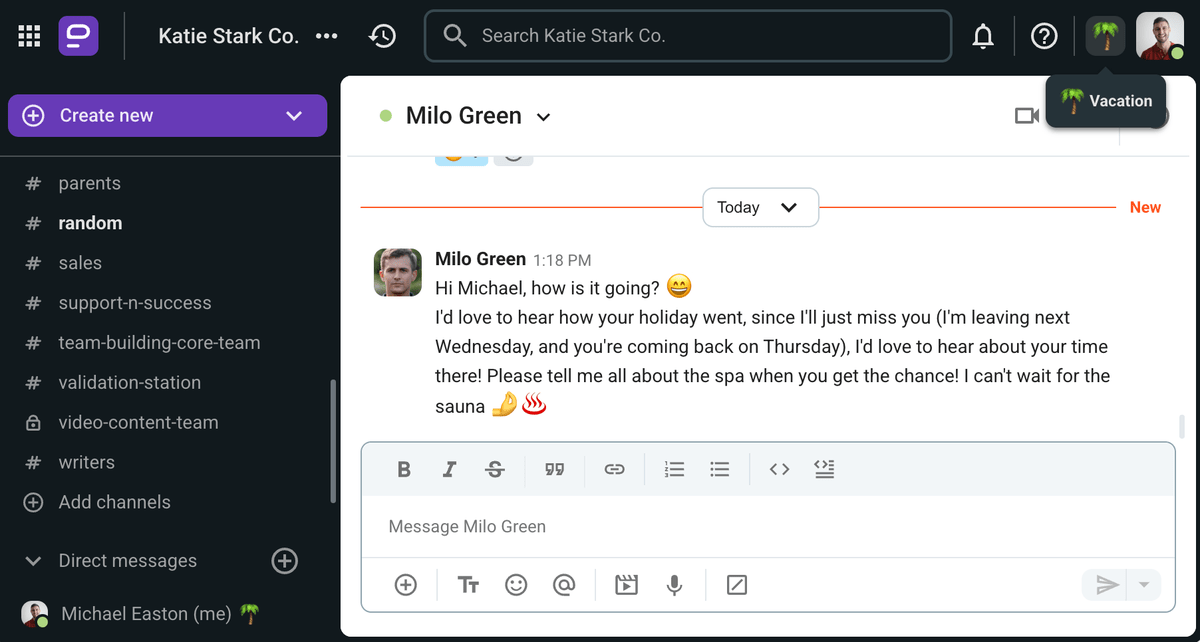
Connectez-vous avec votre équipe sur Pumble
🎓 Astuce Pro de Pumble
Si vous avez du mal à décider quelle méthode de communication choisir, notre guide peut vous aider à décider quel canal de communication vous devez utiliser dans différentes situations :
Types de compétences en communication à améliorer
La communication est généralement classée en 4 catégories :
- La communication écrite,
- La communication verbale,
- La communication non verbale et
- La communication visuelle.
Pour réussir à communiquer, vous devez constamment améliorer vos compétences dans les 4 types de communication.
Notre collaboratrice, Kristie Stocker, ajoute deux autres types à la liste :

« Lorsque la plupart des gens pensent aux compétences en matière de communication, ils pensent qu'il s'agit de la manière de parler aux autres. C'est vrai jusqu'à un certain point, mais la communication est un éventail de modes : verbal, écrit, non verbal, écoute, sans oublier les conversations individuelles, la prise de parole en public et la prise de parole impromptue. Il y a des compétences de base dans lesquelles vous devez exceller, mais cela dépend vraiment de votre fonction. »
Passons en revue les types de communication.
Type n°1 : Compétences en communication écrite
La communication écrite implique l'échange d'informations, de pensées et d'idées par le biais du langage écrit.
Vous aurez besoin de la communication écrite chaque fois que vous voudrez écrire un email, un texte ou un message dans l'application de messagerie de l'équipe. En outre, tout document, rapport ou autre communication écrite officielle doit respecter les normes d'une bonne communication écrite.
La communication écrite est l'un des types de communication les plus utilisés sur le lieu de travail. Elle nous permet d'envoyer et de recevoir des messages dans le temps qu'il faut pour simplement écrire ou lire un email.
L'amélioration des compétences en communication écrite est bénéfique pour la clarté, la précision et l'efficacité de nos messages écrits.
Voici quelques conseils pour une bonne communication écrite, quel que soit le support :
- Organisez vos pensées et vos idées avant de rédiger le message,
- Soyez concis et précis dans vos écrits,
- Utilisez toujours un langage poli et professionnel,
- Relisez tout avant de l'envoyer.
La communication écrite met en évidence votre capacité à rédiger des messages clairs et efficaces. Il s'agit d'un aspect important de votre communication professionnelle, qu'il convient d'améliorer en permanence.
Type n°2 : Compétences en communication verbale
La communication verbale est tout échange d'informations utilisant le langage parlé. Il s'agit d'une forme de communication dynamique qui implique des compétences en matière d'expression orale et d'écoute. Il est essentiel d'améliorer ses compétences en communication verbale si l'on veut s'engager dans des conversations efficaces et percutantes.
Kristie Stocker estime que les compétences en matière de communication verbale sont négligées :

« Au pays des emails et des textes, cette compétence est en train de disparaître, et cela se voit sur le lieu de travail actuel. Beaucoup de choses ne peuvent tout simplement pas être transmises de manière claire par email, en particulier les émotions. Les personnes capables de communiquer verbalement, d'énoncer leur message de manière claire et simple et de l'adapter en fonction de la personnalité ou des besoins de la personne gagnent le jeu de la communication. »
Vous pouvez améliorer vos compétences en matière de communication verbale par les moyens suivants :
- En pratiquant l'écoute active,
- En utilisant un langage approprié et clair,
- En répétant vos discours,
- En développant votre confiance en vous et
- En travaillant votre production vocale.
On considère souvent que les compétences en communication verbale sont innées. Cependant, si vous travaillez et essayez d'améliorer vos compétences de manière constante, vous devriez être en mesure de communiquer avec assurance et éloquence dans n'importe quelle situation.
Type n°3 : Compétences en communication non verbale
La communication non verbale est l'échange d'informations sans l'utilisation de mots. Cela signifie que vous transmettez des messages à travers :
- Le contact visuel,
- Les expressions faciales,
- Les gestes,
- La posture et
- Le ton de la voix.
La communication non verbale peut ajouter différentes couches de sens à une conversation, même lorsqu'elle est effectuée de manière inconsciente. C'est pourquoi vous devez toujours être attentif à vos signes non verbaux et vous efforcer de contrôler vos schémas de communication non verbale.
Pour maîtriser les signaux non verbaux les plus importants, veillez à :
- Toujours vous asseoir ou vous tenir droit,
- Maintenir une posture ouverte,
- Maintenir un contact visuel,
- Garder le sourire,
- Faire attention au ton et au volume de votre voix et
- Respecter les limites physiques.
Une grande partie de la communication non verbale est subconsciente. Elle est donc difficile à contrôler. Cependant, le fait de prêter attention aux signaux non verbaux les plus évidents que vous envoyez peut être bénéfique pour votre communication.
Type n°4 : Compétences en communication visuelle
Vient ensuite la communication visuelle — le processus de transmission d'informations par l'utilisation d'éléments visuels, tels que :
- Les images et les illustrations,
- Les tableaux et les graphiques,
- Les présentations et
- Les signes et les symboles.
La communication visuelle est un moyen pratique de partager des informations comprenant des statistiques, des chiffres et d'autres informations moins digestes.
En fait, la recherche montre que les éléments visuels sont beaucoup plus faciles à traiter que les mots. Une étude a montré que l'utilisation de la couleur dans les documents commerciaux augmente la mémorisation de 82%. De même, l'utilisation de la couleur augmente la compréhension de 73%.
Par conséquent, utilisez des éléments visuels chaque fois que vous le pouvez pour améliorer votre communication.
Qu'est-ce qu'une bonne communication ?
Une bonne communication consiste en un échange d'informations efficace et significatif.
Elle implique d'être capable de transmettre clairement ses pensées et ses idées, tout en sachant écouter. Une bonne communication crée un environnement positif et respectueux pour un dialogue ouvert.
Une communication réussie comporte 3 éléments :
- L'envoi efficace du message,
- La réception correcte du message et
- La compréhension mutuelle et la réalisation d'un objectif commun.
La communication ne peut être réussie que si tous ces éléments sont présents. Par conséquent, vous devez vous efforcer d'être un bon communicateur dans ces 3 domaines.
Élément n°1 : L'envoi efficace du message
L'envoi efficace d'un message est la première étape d'une communication réussie. Il s'agit de rédiger et de délivrer un message avec soin et clarté.
Lors de l'envoi d'un message, il est important de tenir compte du destinataire, de l'objectif et du résultat souhaité. Ensuite, en fonction de ces critères, vous pouvez choisir la langue, le type et la méthode de communication appropriés.
L'envoi efficace d'un message ouvre la voie à une communication ultérieure et à l'obtention du résultat souhaité.
🎓 Astuce Pro de Pumble
Consultez notre guide sur la communication efficace pour en savoir plus sur ce qu'elle est et comment vous pouvez l'améliorer :
Élément n°2 : La réception correcte du message
L'élément suivant d'une communication réussie est la réception correcte du message. Cela implique d'écouter activement l'autre personne, de comprendre et d'interpréter le message avec précision.
Pour vous assurer que vous êtes en mesure de recevoir le message avec précision, vous devez :
- Écouter activement,
- Vous concentrer sur la conversation et limiter les distractions et
- Clarifier les incertitudes pour éviter les erreurs.
Vous devez également être ouvert aux différentes perspectives et essayer de limiter vos idées reçues ou vos préjugés.
Lorsque vous recevez le message voulu, vous pouvez y répondre de manière appropriée et contribuer à une conversation productive.
Élément n°3 : La compréhension mutuelle et réalisation d'un objectif commun
L'objectif final d'une communication réussie est la compréhension mutuelle.
Si vous réussissez à communiquer votre message et que vous recevez correctement le message de l'autre personne, vous devriez être en mesure de parvenir à une compréhension mutuelle.
Sur le lieu de travail, une communication réussie signifie également la réalisation d'un objectif commun. Par exemple, supposons que votre supérieur vous communique avec succès que vous devez terminer une certaine tâche, et que vous écoutez activement et assimilez l'information. Dans ce cas, la voie est libre pour atteindre l'objectif.
Toutefois, si votre supérieur n'a pas communiqué ses attentes ou si vous étiez occupé à d'autres tâches au lieu d'écouter les instructions, vous pourriez rencontrer des problèmes.
C'est pourquoi la communication est extrêmement importante au travail.
Comment communiquer efficacement sur le lieu de travail ?
Une communication efficace est essentielle pour un environnement de travail productif et positif.
Les éléments essentiels d'une communication efficace peuvent être résumés par les 7 C de la communication :
- Clarté,
- Cohérence,
- Confiance,
- Correction,
- Concision,
- Concrétude et
- Courtoisie.
Vous pouvez améliorer vos compétences en communication en comprenant les 7 éléments d'une communication efficace. Nous allons les décrire et vous donner quelques conseils.
Élément n°1 : La clarté
Vous devez communiquer clairement afin d'éviter les malentendus et les erreurs.
Cela signifie simplement que vous devez :
- Vous concentrer sur l'idée et le sens du message que vous voulez transmettre — l'idée principale de votre message doit toujours être claire et évidente.
- Éviter le jargon ou un langage inutilement complexe.
- Utiliser des exemples concrets et donner des instructions claires si nécessaire.
Exprimer vos pensées de manière claire et succincte garantira que votre message sera correctement transmis et compris.
Élément n°2 : La cohérence
La communication cohérente est consistante et logique. Les conversations se déroulent sans heurts et tous les points sont liés et pertinents par rapport au sujet principal de la discussion.
Pour vous assurer que votre communication est cohérente, vous devez :
- Organiser vos pensées et vos idées avant de les présenter,
- Présenter vos pensées et vos idées dans un ordre logique et
- Écouter l'autre personne et répondre en conséquence.
Lorsque vous êtes cohérent dans votre communication, vos pensées et vos idées sont plus crédibles et l'autre personne peut suivre le fil de votre pensée. Cela élimine la confusion, les erreurs et les malentendus.
Élément n°3 : La confiance
La confiance en soi joue un rôle majeur dans la capacité à communiquer efficacement. La confiance en soi améliore votre capacité à vous exprimer clairement. Elle transmet également un sentiment de compétence et d'assurance, ce qui donne plus de crédibilité à vos idées.
Sur le lieu de travail, la confiance en soi est particulièrement importante. Selon une enquête réalisée par Indeed, 98% des travailleurs déclarent être plus performants lorsqu'ils ont confiance en eux. En outre, 94% des employés interrogés déclarent se sentir plus heureux lorsqu'ils ont confiance en eux au travail. La confiance en soi est donc une compétence qui mérite d'être développée.
L'assurance dans la communication peut vous aider à paraître plus sûr de vous :
En outre, le fait d'être confiant peut vous aider à surmonter les obstacles à la communication tels que :
- La peur et l'anxiété,
- Le doute de soi et
- L'hésitation.
Sans ces obstacles, vous pouvez vous exprimer et dialoguer librement avec les autres.
L'enquête a également révélé que la confiance en soi réduit le taux de rotation du personnel. En effet, 96% des employés interrogés déclarent qu'ils sont plus enclins à rester dans une entreprise lorsqu'ils se sentent en confiance.
Par conséquent, la confiance est une compétence bénéfique non seulement pour l'individu, mais aussi pour les organisations dans leur ensemble.
Élément n°4 : La correction
Une communication correcte signifie qu'il n'y a pas d'erreurs dans la communication. Pour être un communicateur correct, vous devez toujours faire attention :
- À la grammaire,
- À la prononciation et
- Au vocabulaire.
Lorsque vous utilisez un langage correct dans votre communication, vous apparaissez plus compétent et plus crédible. Une communication correcte renforce également votre professionnalisme.
De plus, en étant correct dans votre communication, vous évitez les malentendus et la confusion et vous améliorez la compréhension.
Il existe plusieurs moyens de s'assurer que votre communication est correcte :
- Relire chaque message avant de l'envoyer,
- Vérifier si les données que vous envoyez sont correctes (en particulier les noms et les chiffres),
- Consulter les correcteurs grammaticaux et orthographiques en cas de doute et
- Réfléchir à ce que vous voulez dire avant de le dire.
Une communication correcte permet non seulement d'éviter les erreurs, mais aussi de montrer que vous respectez votre interlocuteur.
Élément n°5 : La concision
La concision est une qualité appréciée dans le monde professionnel. Tout le monde apprécie la concision, car elle permet de gagner beaucoup de temps. La concision signifie que vous communiquez votre message en utilisant le moins de mots possible.
Pour communiquer de manière concise, vous devez :
- Supprimer les mots redondants ("vraiment", "très", "peut-être", etc.),
- Ne pas utiliser de mots de remplissage dans la communication orale ("hum", "comme", "je veux dire", "bien", etc.),
- Utiliser des phrases simples et
- Vous tenir à un seul sujet à la fois.
Outre le gain de temps, la communication concise permet également de :
- Rendre le message plus clair pour l'auditeur/le lecteur et
- Mettre mieux en évidence les points essentiels.
Élément n°6 : La concrétude
La communication concrète aide l'auditeur à comprendre exactement ce que vous essayez de dire. Elle vous permet de présenter les informations d'une manière spécifique et vivante.
Pour maintenir le caractère concret de votre communication, vous devrez :
- Utiliser un langage spécifique et clair,
- Éviter les généralisations,
- Fournir des instructions spécifiques,
- Utiliser des modificateurs précis et
- Étayer votre point de vue par des faits et des preuves.
Lorsque vous êtes concret dans votre communication, cela vous aide à :
- Éviter les malentendus,
- Donner de la crédibilité à vos propos et
- Accélérer le travail de l'équipe.
Élément n°7 : La courtoisie
Enfin, soyez toujours courtois dans votre communication.
La courtoisie signifie simplement que vous traitez l'autre personne avec respect. Même dans les situations difficiles, la courtoisie dans la communication est très utile.
Lorsque vous faites preuve de courtoisie et que vous traitez tout le monde avec respect, vous pouvez :
- Créer une équipe saine et productive,
- Construire des relations interpersonnelles positives, et
- Faire en sorte que les membres de l'équipe se sentent appréciés et valorisés.
Traiter tout le monde avec respect est la base de la courtoisie, mais vous devez aussi :
- Être poli et professionnel,
- Être ouvert aux différents points de vue et opinions,
- Penser aux besoins des autres et
- Être honnête et ouvert dans votre communication.
Comment améliorer les compétences en communication sur le lieu de travail ?
Maintenant que nous avons abordé les éléments d'une communication efficace, examinons quelques conseils pratiques sur la manière d'améliorer vos compétences en communication sur le lieu de travail.
Notre collaborateur Chuck Wisner estime que les compétences en matière de communication doivent être pratiquées :

« Les compétences mentionnées ci-dessus demandent de la pratique. Nous adoptons nos modes de communication en fonction de notre famille, de notre éducation et de nos expériences. L'amélioration des compétences en communication passe par la connaissance de soi, l'intelligence émotionnelle et l'expérimentation par essais et erreurs. Pour changer nos schémas, nous devons moins nous juger et juger les autres. »
Voici quelques conseils qui vous aideront à améliorer vos compétences en matière de communication et, si nécessaire, à modifier vos habitudes de communication.
Conseil n°1 : Soyez concis et clair
Les piliers de la communication professionnelle sont l'efficacité et la clarté. Par conséquent, vous devez toujours vous rappeler que votre communication doit être concise et directe.
Kristie Stocker affirme qu'on n'est jamais trop clair :

« Lorsque je m'adresse à des entreprises pour leur parler de compétences en communication, je leur rappelle qu'il n'y a pas de message trop clair. Cela ne signifie pas qu'il faille accumuler des centaines de détails, mais qu'il est préférable que le message soit clair et précis, sans rhétorique. Être clair sur les attentes, les sentiments, les pensées, les idées et tout ce qui se trouve entre les deux est la clé d'une meilleure compréhension pour tout le monde. »
Par conséquent, gardez toujours à l'esprit la concision et la clarté.
Conseil n°2 : Demandez, acceptez et donnez un feedback
Le feedback fait partie intégrante du développement professionnel, car il vous donne la possibilité d'améliorer vos compétences et de vous épanouir dans votre carrière.
Une enquête a révélé que 23% des employés souhaitent un meilleur feedback de la part de leurs supérieurs.
Stocker propose quelques questions à poser pour obtenir un feedback :

« Cherchez à obtenir un feedback.
J'ai été assez clair sur ce point ?
Cela a-t-il un sens ?
A votre avis, quel était le point principal de ce que j'ai dit ?
Il y avait-il autre chose que vous vouliez me dire ?
Écoutez ce que les autres disent et modifiez ce que vous jugez nécessaire. Vous pensiez peut-être avoir été clair à 100 %, mais pour les personnes qui vous donnent leur avis, il y a quelque chose qui n'a pas été compris. »
Par conséquent, n'hésitez pas à demander un feedback et restez toujours ouvert aux commentaires des autres.
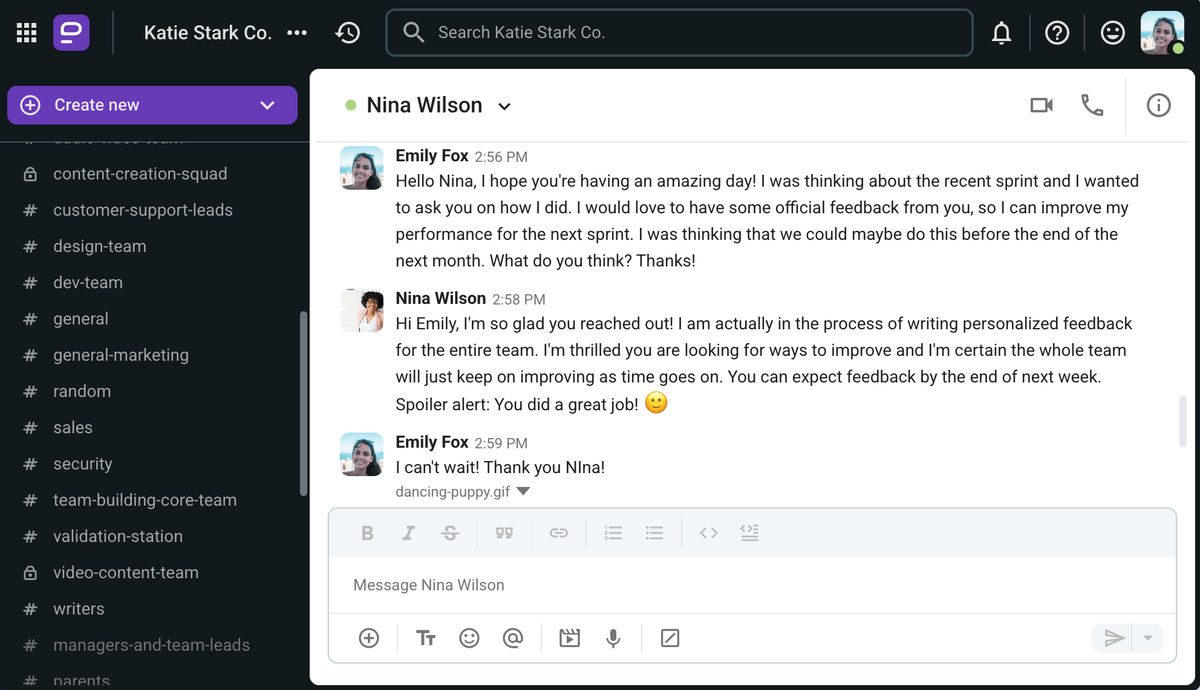
Utiliser Pumble pour partager les commentaires avec simplicité
🎓 Astuce Pro de Pumble
Si la différence entre feedback et feedforward vous intéresse et que vous souhaitez en savoir plus, lisez notre article de blog :
Conseil n°3 : Respectez le temps des autres
Que vous discutiez au bureau ou lors d'un appel vidéo avec votre supérieur, n'oubliez pas que son temps est précieux.
Veillez à ce que votre communication soit concise et précise.
- Ne vous attardez pas trop longtemps sur le bureau de quelqu'un.
- Lors d'une réunion, assurez-vous d'aller à l'essentiel rapidement et de respecter l'ordre du jour de la réunion.
- Dans une application de communication d'équipe, n'hésitez pas à discuter avec les membres de l'équipe, mais n'oubliez pas de respecter leur temps personnel et de ne pas leur envoyer de messages en dehors des heures de travail.
Dans tout type de communication, tenez compte de l'autre personne et respectez son temps.
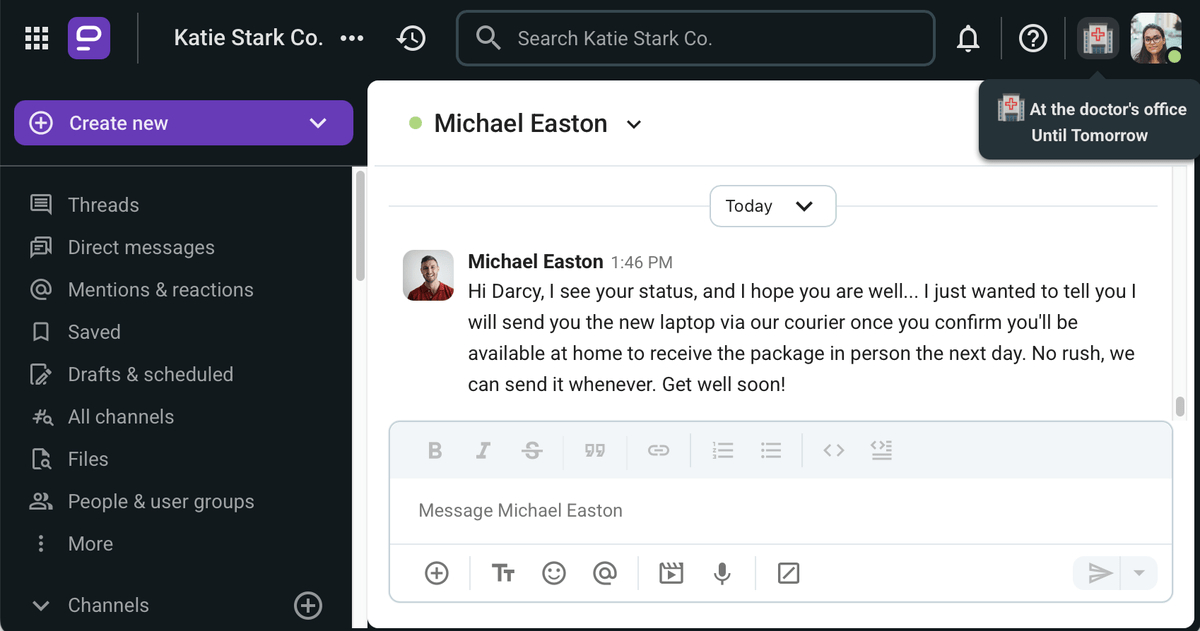
Conseil n°4 : Préparez ce que vous allez dire
Améliorer vos compétences en communication verbale peut s'avérer difficile, en particulier si vous avez le trac ou l'angoisse des réunions.
Dans les situations stressantes, il est préférable d'être préparé. Si vous devez faire une présentation, mais que vous êtes anxieux à l'idée de parler devant d'autres personnes, n'hésitez pas à vous entraîner. Préparez exactement ce que vous allez dire et répétez jusqu'à ce que vous vous sentiez à l'aise et confiant.
Que vous soyez à l'aise ou non avec la prise de parole en public, il vous sera utile de vous entraîner à l'avance.
L'entraînement vous permettra de détecter les points faibles de vos présentations et de votre discours.
En outre, de nombreuses personnes sont angoissées par les conversations difficiles qu'elles doivent avoir avec les membres de leur équipe. Il peut s'agir de demander de l'aide, de donner un retour d'information ou de parler d'argent.
Quelle que soit la situation, il est préférable de planifier à l'avance et de se préparer à toute question, tout désaccord ou toute demande d'information supplémentaire. En étant préparé, vous pouvez y répondre de manière calme et constructive .
Prévoir est le meilleur moyen de réduire le stress et l'anxiété et d'améliorer la communication.
Conseil n°5 : Soyez prêt à recevoir des réponses inattendues
L'une des caractéristiques essentielles d'un auditeur actif et d'un communicateur efficace est d'écouter sans porter de jugement.
Mettez-vous à la place de l'autre personne et réfléchissez à son point de vue. Écoutez sans interrompre et veillez à ne pas vous laisser influencer par vos idées préconçues et vos préjugés.
Soyez également prêt à entendre des informations ou des commentaires négatifs, et vous serez prêt à accepter ou à réfuter les points de vue opposés.
Conseil n°6 : Éliminez les mots de remplissage et les non-mots de la conversation
Un autre conseil pour une meilleure communication verbale est d'éliminer les mots de remplissage et les non-mots.
Vous pouvez améliorer considérablement votre communication orale en vous familiarisant avec les pauses. Les pauses dans votre discours peuvent vous aider à rassembler vos idées et à reprendre votre souffle. Vous n'avez donc plus besoin de remplir la conversation de mots et de non-mots.
Les mots de remplissage sont également connus sous le nom de disfluences vocales ou d'hésitations. Les mots tels que « comme », « bien » et « donc » sont les plus courants. Il existe également des phrases de remplissage, telles que :
- « À mon avis »,
- « Inutile de dire »,
- « Vous savez » et
- « Eh bien, en gros ».
Les non-mots sont des sons de remplissage qui n'ont pas de sens, comme par exemple :
- « Un », et
- « Ah », et
- « Hmm ».
Il y a plusieurs choses que vous devez faire si vous voulez éliminer les mots et les sons de remplissage de votre discours :
- Entraînez-vous à parler et écoutez-vous,
- Faites une pause et profitez du silence entre les pensées,
- Parlez lentement et clairement et
- Utilisez des phrases plus courtes.
Il n'est pas facile d'éliminer complètement les mots et les sons parasites de votre discours, mais avec un peu d'entraînement, vous pouvez réduire leur fréquence.
Conseil n°7 : Posez des questions
Pour être sûr de bien comprendre ce qui se dit, n'hésitez pas à poser des questions.
En posant des questions, vous montrerez également que vous êtes engagé et que vous écoutez activement l'autre personne.
Veillez à poser des questions ouvertes afin d'obtenir des réponses pertinentes et de poursuivre la conversation.
Cela permettra à l'orateur :
- Clarifier ses opinions,
- Considérer d'autres points de vue ou
- Réfléchir encore plus profondément au sujet.
Katie Stocker croit en l'importance de se poser des questions tout en écoutant afin de contribuer à la conversation. Voici quelques-unes des questions qu'elle trouve utiles :

« Qu'est-ce qu'ils disent vraiment ?
Où veulent-ils en venir ?
Y a-t-il un message important derrière ce qu'ils disent que je devrais prendre en considération ?
Ce sont là quelques questions initiales à se poser lorsqu'on écoute. »
Poser les bonnes questions est le catalyseur de bonnes conversations, alors posez-les.
Conseil n°8 : Évitez les distractions
Éviter les distractions doit être une priorité, que vous parliez à quelqu'un en personne ou que vous discutiez via une application de messagerie professionnelle.
- Essayez d'être présent dans la conversation et limitez les interruptions possibles, comme votre téléphone ou votre ordinateur portable.
- Si vous participez à une réunion importante, désactivez vos notifications.
- Au bureau, rangez votre téléphone lorsque vous parlez à un membre de l'équipe.
Katie Stocker reconnaît que les distractions nuisent à la communication :

« Lorsque l'on communique avec quelqu'un, il devrait être la personne la plus importante dans la pièce. J'ai remarqué que dans notre société, les gens ignorent la personne qui se trouve en face d'eux et consacrent leur énergie à un appareil électronique (une distraction !). Mon plus grand conseil, si vous voulez que quelqu'un se sente écouté, regardez-le lorsqu'il parle. Vous pouvez « dire » que vous l'écoutez, mais regarder votre téléphone, la télévision ou n'importe quel autre appareil pendant qu'il parle est tout simplement impoli. La personne ne se sentira pas importante, elle se sentira moins valorisée et ce sentiment peut se propager. »
Accordez toute votre attention à l'autre personne pour lui témoigner votre respect et contribuer à une conversation constructive.
Conseil n°9 : Utilisez les outils de communication
Les outils de communication sont des logiciels ou du matériel qui permettent aux équipes de communiquer et de collaborer. Les outils de communication, tels que les applications de communication d'équipe, peuvent aider les équipes à se connecter et à collaborer plus rapidement et plus facilement, en particulier dans un environnement de travail à distance.
Notre collaboratrice, Smita Des Jain, estime qu'il est important d'être ouvert et flexible pour utiliser les nouvelles technologies :

« Avec l'utilisation croissante des outils de communication numérique, il est important de s'adapter et de savoir utiliser la technologie de manière efficace. Apprenez à utiliser différentes plateformes, outils et canaux pour communiquer efficacement. »
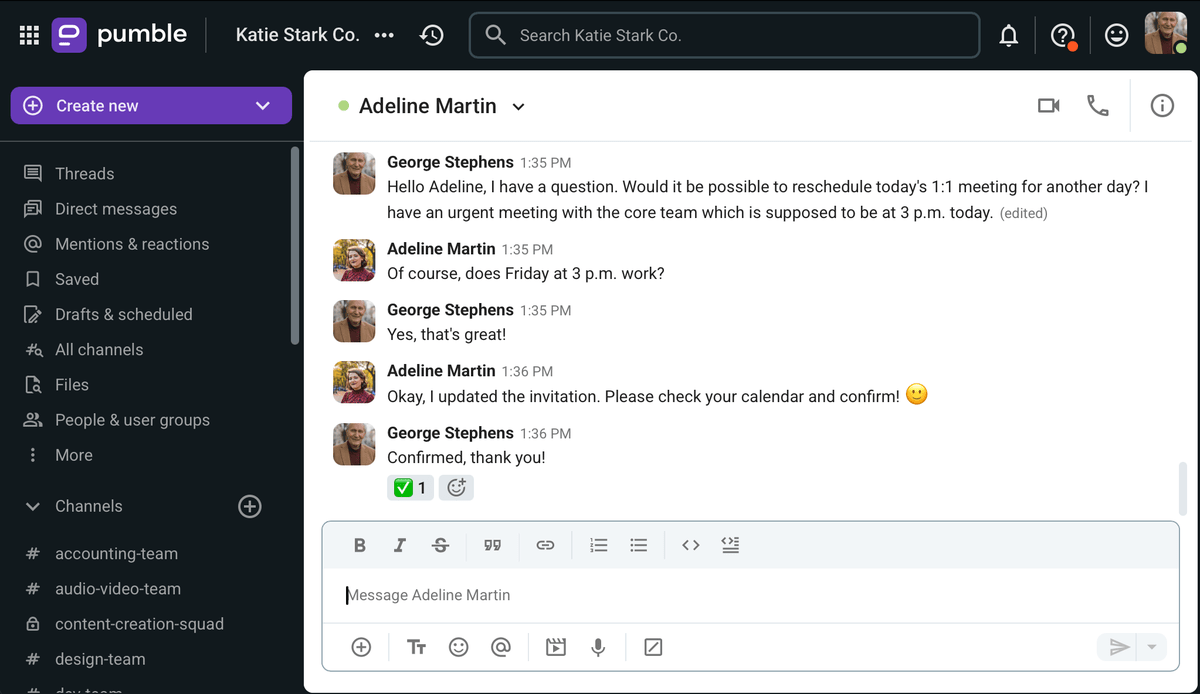
Conseil n°10 : Faites preuve d'auto-réflexion
Pour commencer à améliorer vos compétences en matière de communication, vous devez d'abord faire le point sur la situation actuelle. Évaluez vos forces et vos faiblesses et identifiez les domaines à améliorer.
Winser est également d'avis que l'autoréflexion est la clé de l'amélioration des compétences en communication :

« Commencez à améliorer vos compétences en communication en remarquant vos schémas personnels. Quelles sont les personnes ou les types d'interactions qui vous poussent à avoir des réactions défensives ? Quel est votre mode de fonctionnement lorsque vous défendez vos opinions? Quels sont vos schémas d'écoute ? Commencez à noter comment vous posez des questions. Sont-elles sincères ? Sont-elles accusatrices ? Êtes-vous ouvert à l'idée d'apprendre quelque chose de nouveau ? »
Lorsque vous aurez identifié les compétences à améliorer, vous pourrez commencer à mettre en œuvre nos conseils et stratégies pour une meilleure communication.
🎓 Astuce Pro de Pumble
Vous cherchez plus de stratégies de communication en équipe? Voici notre article sur ce sujet :
Pourquoi est-il important d'avoir de bonnes compétences en communication ?
De bonnes compétences en communication sont bénéfiques à bien des égards. En particulier, une bonne communication a un impact positif sur :
- Le bonheur et le bien-être des employés,
- L'engagement des employés,
- La productivité,
- La fidélisation des employés et
- La santé financière des entreprises.
D'après l'expérience de Chuck Winser, les compétences en matière de communication sont essentielles pour que les équipes soient efficaces et productives :

« Les conversations sont le seul outil que nous partageons pour faire avancer les choses. Au cours des trente dernières années, j'ai vu des individus et des équipes se retrouver bloqués parce qu'ils avaient besoin d'apprendre à parler, à écouter et à interagir plus habilement.
Quel que soit le type de travail que nous effectuons, nous avons tous la capacité et la responsabilité d'avoir des conversations conscientes. Des conversations plus conscientes permettent d'être plus intelligent avec les autres, de créer des idées et de prendre des décisions plus sages. »
Examinons plus en détail les avantages d'une bonne communication.
Avantage n°1 : Une bonne communication rend les employés plus heureux
Une bonne communication sur le lieu de travail est un facteur prédictif important du bonheur et du bien-être des employés.
Selon une revue de la littérature sur le lien entre la communication et le bonheur des employés, les canaux de communication ouverts sont un facteur majeur de bonheur pour les employés. La recherche a montré l'importance d'une communication ouverte dans toutes les directions. En d'autres termes, la communication descendante est aussi cruciale que la communication ascendante et horizontale.
En outre, selon le Connected Culture Report, les employés des équipes qui valorisent la connexion font état d'un meilleur bien-être physique et émotionnel.
Favoriser une bonne communication sur le lieu de travail crée un environnement dans lequel les employés se sentent connectés et informés, ce qui les rend plus heureux et en meilleure santé.
Avantage n°2 : Une bonne communication augmente la productivité
Les équipes connectées font également état d'une plus grande productivité.
Selon le rapport The State of Business Communication 72% des chefs d'entreprise estiment qu'une communication efficace a augmenté la productivité de leurs équipes. La même étude a également montré qu'une communication efficace a un effet positif sur la confiance des employés, ce qui a également un effet positif sur la productivité.
Par conséquent, si vous voulez que votre entreprise prospère et que vos employés soient productifs, faites d'une bonne communication une priorité.
Avantage n°3 : Une bonne communication accroît l'engagement
Les employés désengagés coûtent au monde 8,8 billions de dollars en perte de productivité, selon le rapport State of the Global Workplace de Gallup.
Au cœur du problème se trouve un manque de communication qui entraîne le désengagement des employés.
Premièrement, les entreprises ne communiquent pas leurs valeurs et leurs stratégies à leurs employés. C'est une occasion manquée pour les employés de se sentir liés à l'organisation à un niveau plus profond.
En outre, avec l'essor du travail à distance, les employés éloignés ont tendance à se sentir encore plus désengagés. Dans ce cas, les entreprises ne parviennent pas à ouvrir divers canaux de communication pour s'assurer que leurs employés à distance se sentent inclus.
Le rapport Gallup a révélé que seuls 23% des travailleurs dans le monde sont engagés. Pour changer cette situation, les bonnes pratiques de communication doivent figurer au premier plan des valeurs de chaque entreprise.
🎓 Astuce Pro de Pumble
Si vous êtes intéressé par les statistiques autour de l'engagement des employés et le coût d'un mauvais engagement, consultez notre guide :
Avantage n°4 : Une bonne communication favorise la fidélisation des employés
Comme nous l'avons vu, une bonne communication accroît l'engagement des employés, ce qui influe sur la productivité – le rapport State of People Strategy 2025 de Lattice a révélé que 56 % des équipes très performantes proviennent d'entreprises qui accordent la priorité à l'engagement..
Tout cela affecte la fidélisation des employés, car les employés engagés qui obtiennent de bons résultats sont moins susceptibles de quitter leur entreprise.
En d'autres termes, une bonne communication favorise l'engagement des employés, et l'engagement favorise la fidélisation des employés.
Avantage n°5 : Une bonne communication permet d'économiser de l'argent
L'une des conséquences d'une mauvaise communication est la perte d'argent.
En effet, 38% des chefs d'entreprise ont constaté l'impact financier d'une mauvaise communication, selon le rapport State of Business Communication 2023 déjà cité. En outre, le rapport estime qu'une mauvaise communication coûte aux entreprises américaines 1,2 billion de dollars par an.
Un rapport d'Axios HQ, qui a interrogé 540 chefs d'entreprise et plus d'un millier d'employés, estime que le manque de communication coûte aux entreprises américaines plus de $2 milliards de dollars par an.
Il est évident qu'un manque de compétences en communication nuit au succès des organisations. Développer et entretenir les compétences en communication est un investissement qui porte ses fruits.
Exemples de bonnes aptitudes à la communication
Maintenant que vous savez tout sur les compétences en matière de communication, examinons quelques exemples de bonne communication sur le lieu de travail.
Exemple n°1 : Une communication claire et honnêteté
Dans cet exemple, le manager Nina, contacte Adeline via l'application de communication avec les employés, Pumble, pour faire le point sur un projet. Adeline a rencontré quelques difficultés en cours de route.
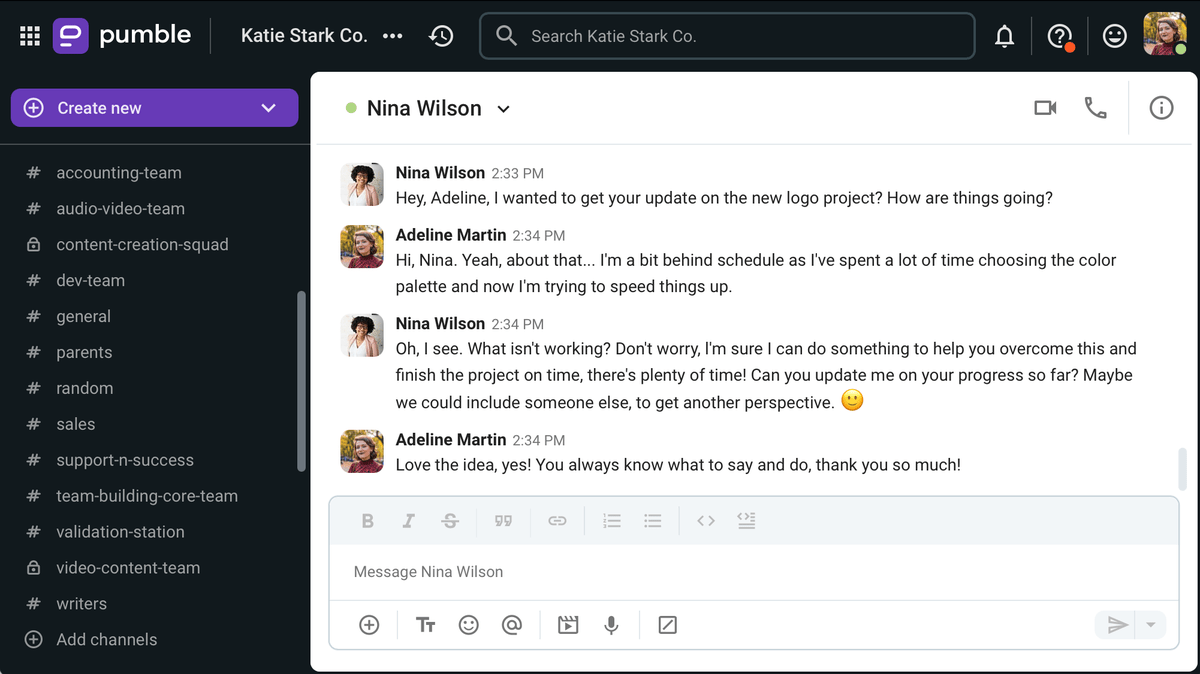
Encourager une communication d'équipe efficace avec Pumble
Cette conversation témoigne de bonnes compétences en matière de communication de la part des deux parties. Tout d'abord, en tant que manager, Nina a pris la responsabilité de contacter Adeline pour prendre de ses nouvelles. Elle va droit au but en envoyant un message clair et concis pour demander des nouvelles.
Adeline répond honnêtement et admet qu'elle a des difficultés à respecter le planning.
Nina fait ensuite preuve d'intelligence émotionnelle dans son message suivant. Elle fait preuve d'empathie à l'égard d'Adeline et lui apporte son soutien. Nina propose également une solution claire pour remédier à la situation. Elle fait tout cela en gardant une attitude amicale et positive à l'égard d'Adeline.
Adeline termine par un message poli et professionnel qui témoigne d'une compréhension mutuelle.
Exemple n°2 : Une communication ouverte et empathie
Dans l'exemple suivant, nous avons une conversation entre un manager et un membre de l'équipe. Jessica, le manager, a remarqué un changement dans les performances de Darcy et veut savoir si elle va bien :
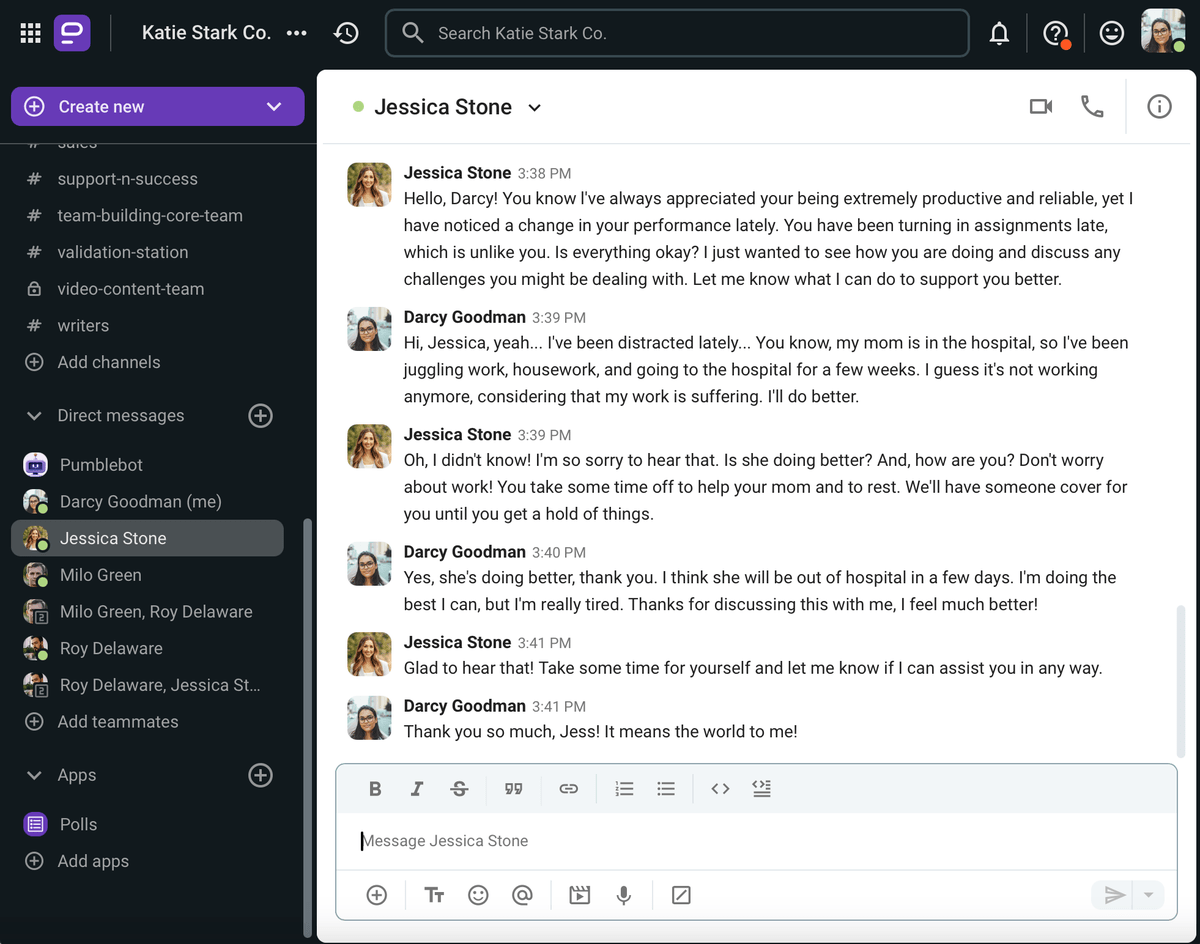
Ici, nous pouvons clairement voir plusieurs compétences différentes pour une bonne communication. Tout d'abord, Jessica fait preuve d'empathie en posant des questions sincères sur le bien-être de Darcy. Elle aborde également le sujet de manière positive en complimentant le travail passé de Darcy avant de souligner les changements récents dans ses performances.
Darcy est ouverte et honnête avec Jessica et lui fait savoir de manière concise qu'elle a des difficultés. Darcy montre également qu'elle est immédiatement prête à accepter un retour d'information.
Jessica then empathizes with Darcy and offers clear solutions.
La conversation se déroule de manière cohérente, et Jessica comme Darcy se sentent mieux à la fin.
Exemple n°3 : Une amabilité et de la concrétude
Dans cet exemple, une équipe de conception de produits discute de la palette de couleurs d'un produit. Bien que plusieurs membres de l'équipe communiquent, la conversation se déroule de manière cohérente et les membres de l'équipe parviennent à une compréhension mutuelle.

Darcy et Roy font preuve d'une attitude amicale et positive dans cette discussion de groupe en complimentant les choix de l'équipe.
John pose quelques questions pour approfondir la conversation et tenter d'aborder le sujet sous différents angles.
Emily réagit de manière réfléchie et répond à l'offre de John pour un examen plus approfondi. Il fait également preuve d'une attitude amicale en reconnaissant que John est un nouveau venu dans l'équipe.
John conclut ensuite la conversation par une réponse concrète, assortie de données de recherche. Cela donne de la crédibilité à ses propos.
Exemple n°4 : Quand la communication ne fonctionne pas
Dans cet exemple, 3 membres d'une équipe tentent de parvenir à un accord commun. Cependant, l'un d'entre eux est frustré et renonce à trouver un compromis :
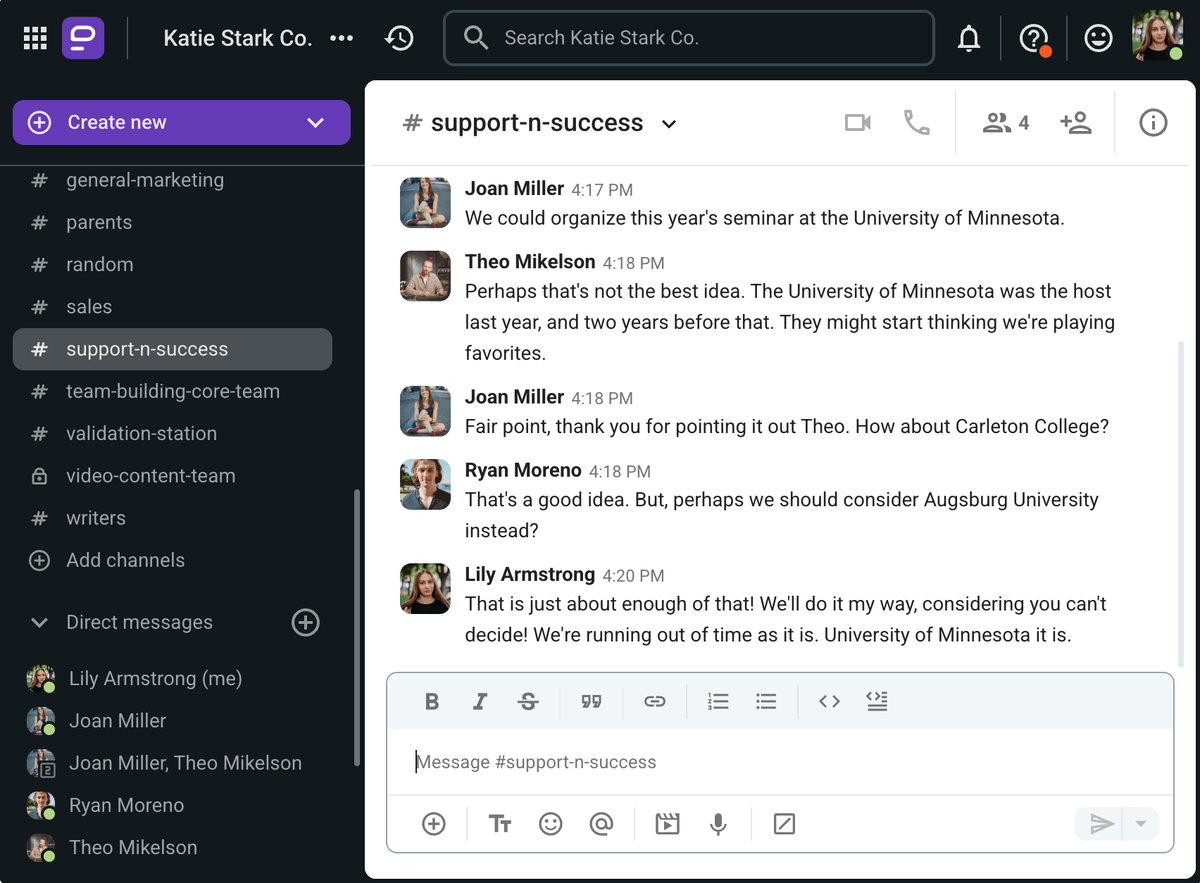
Joan, Théo et Ryan essaient de trouver une solution qui convienne à tout le monde. Ils font preuve de professionnalisme et de clarté. Théo est également confiant dans ses suggestions pour une meilleure solution.
Ils sont tous concis, cohérents et engagés dans la conversation.
Cependant, Lily se sent frustrée par le processus de décision sur la meilleure solution et coupe court à la conversation. Elle impose ses opinions à l'équipe et met fin à toute discussion. Bien qu'elle soit indubitablement claire dans sa communication, la manière dont elle transmet son message est impolie et non professionnelle.
Améliorez vos compétences en communication avec Pumble
Le processus de communication peut rapidement se compliquer sur le lieu de travail. C'est pourquoi il est important d'optimiser votre communication et de l'organiser de manière à ce qu'elle soit facile à comprendre et à apprendre.
L'utilisation de plateformes de communication d'équipe comme Pumble peut vous aider à transformer complètement la communication sur le lieu de travail. Pumble est un QG numérique simple et polyvalent qui permet à l'ensemble de l'équipe d'être informé en permanence de toutes les informations pertinentes.
Les principales fonctionnalités de Pumble sont les suivantes :
- Messages directs — pour suivre les informations importantes,
- Canaux — pour organiser les membres de l'équipe et les informations dans des espaces dédiés,
- Visioconférence — pour améliorer la communication non verbale lors des réunions en face à face, et
- Notifications personnalisées — pour créer des limites de communication personnalisées.
Votre centre de communication numérique est l'endroit idéal pour favoriser l'exactitude, la concision, la confiance et la clarté.
Développez les compétences de communication les plus importantes et ne perdez jamais le rythme –créez un compte Pumble gratuit dès aujourd'hui !
Comment nous examinons cet article : Nos rédacteurs et éditeurs vérifient les articles et les mettent à jour lorsque de nouvelles informations sont disponibles, afin qu'ils soient toujours d'actualité.

